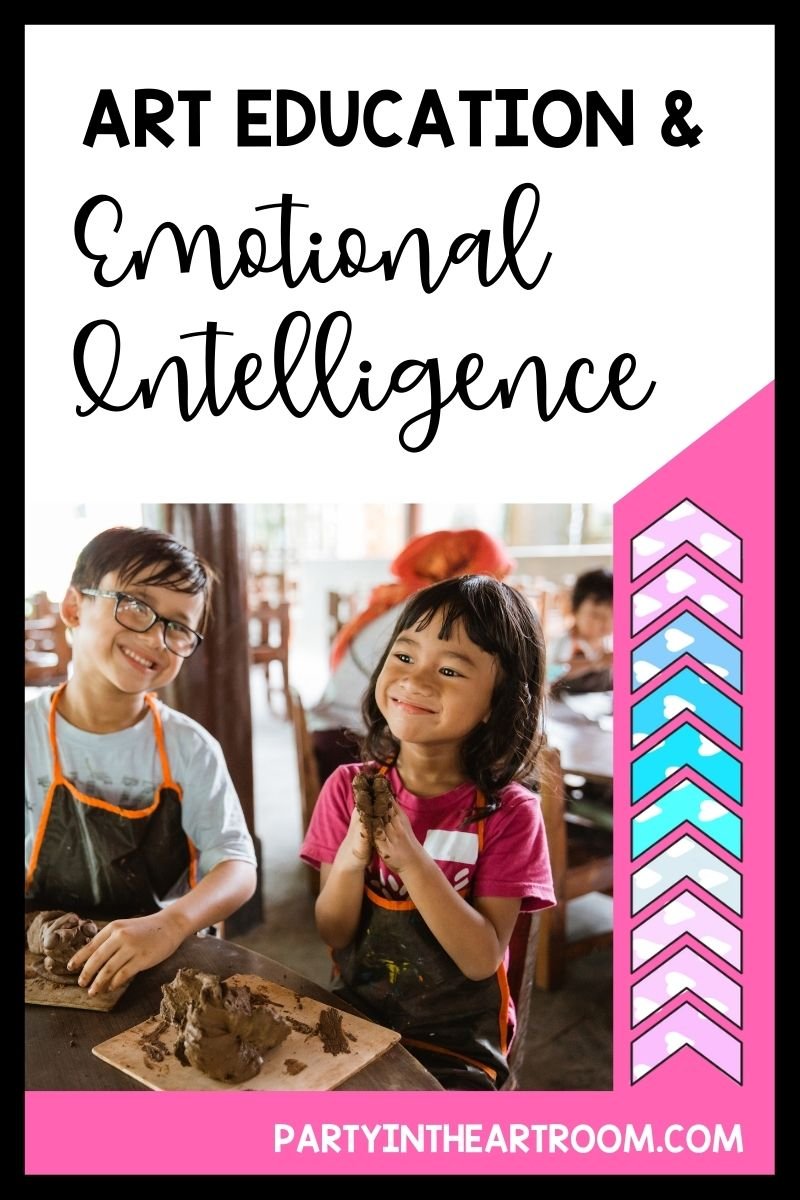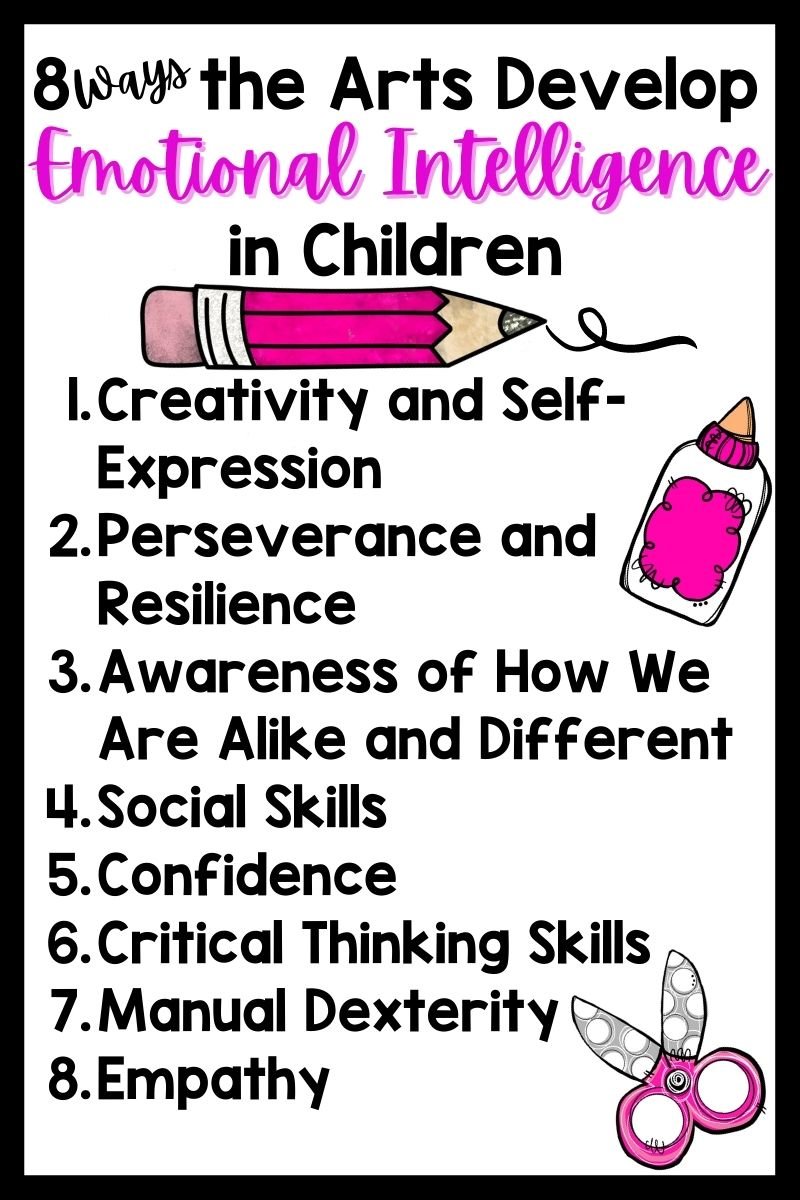Why Art Education is Important for Developing Emotional Intelligence in Children
Art education in communities is often overlooked as an inferior subject. Two thumbs down to that!
Some people think art classes are just there to pass the time, or that they have little impact academically, but research shows how art can positively impact overall academic performance, and other skillsets which are needed for the development of children to become well rounded individuals, who will become our future.
In other words, an education rich in the arts meets the needs of the whole child.
Let’s give that two thumbs up!
We all have emotions and how we deal with those emotions translates to how we function as human beings, this is known as emotional intelligence and can be explored through art. Think: social emotional learning.
What is emotional intelligence?
Emotional intelligence is a fairly new phycological concept that encapsulates how a person’s personality processes feelings, passions, emotions, self-control, and motivation.
How an individual’s personality develops is a complex process, but there is evidence to show many of the traits we form as adults are dependent on our experiences in childhood and early life. For example, what we do in school can shape how we function and interact with others as adults. These early stages of development also include the incorporation of psychological trauma, feelings of inferiority, aggressiveness, vulnerability and possessiveness. All of which need to be processed so they do not negatively impact our behavior.
Again, think: social emotional learning. The tenets of social emotional learning are self-awareness, social awareness, self-management skills, social skills, and decision making skills.
Why is emotional intelligence relevant today?
Emotional intelligence is more relevant today than ever. Taking an emotional intelligence test is a way to determine a person’s behavior, choices, and work ethics. It gives insights into a person’s management style or interpersonal skills and has become an important profiling tool for job interviews, customer services, and a vital skill in how to show up in the world as adults in general.
Plus, we are learning more and better ways to teach students through social emotional learning activities. It’s best practice in meeting the needs of the whole child.
How is art beneficial to emotional intelligence?
As teachers our role can have an impact on how a child develops and incorporating art within our teaching processes will help to encourage the exploration and development of emotional intelligence in the following ways:
Creativity and Self-Expression
All forms of the creative arts involve emotional intelligence. Art is a significant way in which a child can express themselves, often (hopefully) openly without judgement.
There is a lot of room for creativity and individuality in an art class, and it calls onto children to think creatively and use innovation to create something different and new. It challenges thought patterns: perhaps they need to think about something in a different way, explore new ideas and concepts, or even find a new way to solve a common problem.
One time, I had some students that helped me solve the issue of people not keeping the general materials organized. They got everything organized and took photos of how it should look. Then, they used the photos to make posters for me in Canva.
They added text and other graphic elements. Then, I used the images in my presentations at the beginning of the year and for refreshers after holiday breaks. I also had the posters printed and hung them on the wall. It made it so much easier for all of the students to remember what to do to keep things organized.
They basically used graphic design and art-thinking processes to solve that common problem in our classroom. The result made our classroom environment better for everyone.
Perseverance and Resilience
As with any skill, arts need to be practiced to in order to be mastered. Learning to draw or to paint is another way to develop resilience, perseverance, and dedication within an individual, a trait which serves us through our entire lives.
As adults we need these skills to survive and not give into negative emotions which can lead to depression.
A good example is the life of an entrepreneur who repeatedly has to take risks and fail multiple times in order to succeed. This is very much like an artist developing their art, they have to keep working at it.
Art can help process these feelings and self-regulate moods and control emotions.
Awareness of How We Are Alike and Different
Art is a great way to explore diversity in culture and nurture understanding and celebration of it, especially as we live in such a multi-cultural society today.
A child can use art to initiate conversation on cultural heritage and home life, but also learn about others in the classroom. Art helps to develop a world view, and there is always space to learn new things which keeps it interesting and stimulating.
This is how we can ensure our children are truth-seekers and peacemakers to the betterment of everyone’s future.
Social Skills
Art projects are a great way to encourage collaboration between children and give them an outlet to work in groups to develop their social skills. They can work on their communication, teamwork and listening skills.
There is also a level of accountability on children to deliver their part of the work in a group setting, so they can learn about responsibility, again these are all important traits we need as functioning adults.
Art Builds Confidence
Artists have to be brave; they have to make their own decisions and follow what they feel and be honest with those feelings. Being bold in the art classroom is a way to build confidence.
Sharing ideas and experiences through self-expression gives children the space to be different, and ultimately be true to themselves. They are more likely to be more expressive in the world in adulthood.
Critical Thinking Skills
Art is an outlet to process and interpret what is going on around us, it develops critical thinking skills which are needed in real world situations.
Manual Dexterity
Art can be very hands on, the use of paintbrushes crayons, pencils, fabrics, and other tools with different textures helps to develop physical skills such as manual dexterity and hand-eye coordination.
These are vital skills in everyday life as adults, for example we use tools in the kitchen to cook, or for DIY purposes in the house or place of business. It can also help children determine which type of skillsets they enjoy more.
Empathy
To develop empathy, which is an important part of adulthood, you must be able to understand another person’s wants and needs. Art is a way to communicate those wants and needs, to express moods and feelings when it may not be possible verbally or by any other means. Children especially may not have the vocabulary to express themselves, but they can create an image.
Art is a way in which we can understand each other and share commonalities and discuss important topics.
Art is Plain Ol’ Good for Us
In general, art is an all-inclusive subject! It has something for everyone to enjoy, and it improves overall health and happiness. This is why art education is important in developing emotional intelligence in our communities, as it helps children to learn to not only process and regulate their emotions, but it will help children learn the interpersonal skills that they need later in life as adults.
Ready to learn more?
Join the WAITLIST for our ALL ACCESS VIP PASS to the most innovative and empowering
WHOLE CHILD curriculum library on the market.
Our all access Whole Child curriculum library includes every lesson plan, art ed game, professional development resource, worksheet, instructional video, etc. ever created by Party in the Art Room. That's over a decade's worth of amazing content.
Sign up below to get on our waitlist. We are looking for passionate educators to empower with our proven Whole Child methodology. The library opens soon!!

